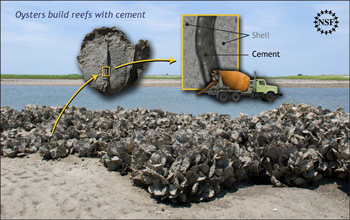While on vacation, I came across this research published in 2009 that was new to me and very interesting. A five-year study of oyster-restoration techniques in Chesapeake Bay shows that taller reefs worked better in oyster restoration efforts.
A study conducted by
Virginia Institute of Marine Science graduate students David Schulte, Russ Burke, and professor Rom Lipcius appeared in the July 30th issue of Science Express.
Link to study. Oysters showed greater abundance and growth on reefs built to stand 10-18 inches above the seafloor with reefs that rise only 3-5 inches.
The US Army Corps of Engineers constructed the reefs in 2004 by placing old oyster shells in 9 discrete sets of reefs covering more than 90 acres in the Great Wicomico River, a small Chesapeake Bay tributary, which is permanently closed to oyster harvesting.
In the area used in this study there is a natural oyster set meaning that local oysters reproduce and release young oyster spat. The spat then attach to suitable substrates that usually contain calcium. A very attractive substrate material is oyster shell, but other calcium containing material including concrete cinderblocks will work as well. On follow-up the taller reefs had four times as many oysters as the shorter reefs, and the oysters on the taller reefs were growing faster than those growing closer to the bottom.
The taller reef areas held the highest densities of oysters ever recorded on a restored oyster reef in the Bay with more than 1,000 oysters per square meter. Pre-restoration surveys of the study area recorded fewer than 2 oysters per square meter. Those numbers are important as the oysters in one square meter could filter 30,000 gallons of water per day or 900,000 gallons per month. (How many square meters are there in 90 acres?- Wow!)
Taller reefs may be more successful because the oysters may receive more water flow delivering nutrients and the oysters may be protected from sedimentation.
The taller reefs have persisted and grown for nearly five years, indicating that the threshold for long term success may have been achieved. And they are approaching the form of a natural unharvested reef that once was prevalent throughout the Bay. Harvesting has reduced oyster abundance around the world to less than 1% of its original presence.
At the Massachusetts Oyster Project we have not yet laid down oyster shell to build up reef structure for oysters. We have not pursued this for two reasons. First, we have been focused on proving out that oysters can survive and grow in Boston Harbor estuaries. (There was considerable skepticism about this when we began this oyster restoration program.) And second, we have not yet devoted the time to figuring out the labyrinth of regulations for placing oyster shell on the bottom. However, we do have a volunteer exploring this and hope to commence a program like this in the next few years. We are hoping to have some reproduction this year and are eagerly watching for signs of it.
Our results also indicate that oysters that are a bit higher up and in the current seem to do better than those on the bottom. We also have learned the hard way about the dangers and difficulties of sedimentation, which greatly affected the class of 2008.
Let us hope that this and other successes will encourage the Army Corps of Engineers and other government bodies to consider funding similar programs in Massachusetts waters. Boston Harbor has improved dramatically over the past 20 years and we would welcome additional shoulders at the wheel working to restore this keystone species.


































.JPG)








